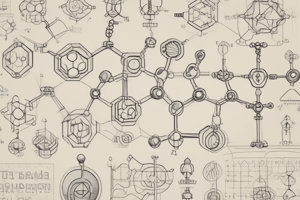Podcast
Questions and Answers
What is the general representation of a tertiary amine?
What is the general representation of a tertiary amine?
- R3N (correct)
- R4N
- R2NH
- RNH2
What happens when a primary amine is treated with alcoholic potassium hydroxide and chloroform?
What happens when a primary amine is treated with alcoholic potassium hydroxide and chloroform?
- An offensive smelling isocyanide is formed (correct)
- A yellow oily nitrosoamine is formed
- Nitrogen gas is produced
- An orange coloured azo dye is formed
What is the result of reacting aromatic primary amines with nitrous acid?
What is the result of reacting aromatic primary amines with nitrous acid?
- An offensive smelling isocyanide is formed
- Diazonium salts are formed (correct)
- A yellow oily nitrosoamine is formed
- Nitrogen gas is produced
What is the result of reacting secondary amines with nitrous acid?
What is the result of reacting secondary amines with nitrous acid?
What is the general representation of a secondary amine?
What is the general representation of a secondary amine?
What happens when a primary aliphatic amine reacts with nitrous acid?
What happens when a primary aliphatic amine reacts with nitrous acid?
What is the result of reacting tertiary amines with nitrous acid?
What is the result of reacting tertiary amines with nitrous acid?
What is the characteristic of amines in terms of their pH?
What is the characteristic of amines in terms of their pH?
What is the purpose of the Litmus Test?
What is the purpose of the Litmus Test?
What is the purpose of the Azo-Dye Test?
What is the purpose of the Azo-Dye Test?
Study Notes
Tests for Unsaturation
- Saturated hydrocarbons (alkanes) contain only single bonds, while unsaturated hydrocarbons (alkenes and alkynes) have double or triple carbon-carbon bonds.
- Two qualitative tests for unsaturation:
- Bromine Test: Orange-red color of bromine solution disappears in the presence of unsaturated compounds.
- Baeyer’s Test (Alkaline KMnO4 Test): Pink color of KMnO4 fades when reacting with unsaturated hydrocarbons, possibly forming brown MnO2 precipitate.
Tests for Alcoholic Group
- Alcohols contain a hydroxyl group (-OH) attached to an aliphatic carbon; categorized as mono (one -OH), di (two -OH), or trihydric (three -OH).
- Alcohols can be primary (1°), secondary (2°), or tertiary (3°) based on the carbon to which the -OH is bonded.
- Sodium Metal Test: Alcohols react with sodium, releasing hydrogen gas (effervescence).
- Ester Test: Alcohols react with carboxylic acids to form esters, with sulfuric acid as a catalyst.
- Ceric Ammonium Nitrate Test: Alcohols react with ceric ammonium nitrate, yielding red alkoxy cerium (IV) compound.
- Acetyl Chloride Test: Alcohols form esters with acetyl chloride and release HCl gas, producing white ammonium chloride fumes with ammonium hydroxide.
- Iodoform Test: Positive for acetaldehyde, methyl ketones, and alcohols with CH3-CH-OH group, indicated by yellow precipitate of iodoform (CHI3).
Tests for Phenolic Group
- Phenols contain -OH group attached to an aromatic ring, often colorless but can turn colored upon oxidation.
- Examples include o-cresol, m-cresol, p-cresol, quinol, and catechol.
- Litmus Test: Phenol, being a weak acid, turns blue litmus paper red.
- Ferric Chloride Test: Reaction with ferric ions produces a violet complex.
- Liebermann’s Test: Treatment with sodium nitrite and concentrated sulfuric acid yields deep blue/green, switching to red or brown with water; blue/green can regenerate with strong alkali.
- Phthalein Dye Test: Heating phenol with phthalic anhydride and sulfuric acid forms colorless phenolphthalein, which turns pink in alkali.
Tests for Aldehydic and Ketonic Groups
- Aldehydes and ketones are characterized by a carbonyl group (C=O).
- Aldehydes have the carbonyl carbon bonded to at least one hydrogen; formaldehyde has two hydrogens. Ketones have the carbonyl carbon bonded to two carbon groups.
- 2,4-Dinitrophenyl Hydrazine Test (2,4-DNP Test): Detects carbonyl groups; a positive result yields yellow/orange-red precipitate.
- Sodium Bisulfite Test: Aldehydes and ketones form white crystalline addition products with sodium bisulfite.
- Differentiating tests for aldehydes:
- Schiff’s Test: Produces pink or magenta with Schiff’s reagent.
- Tollen’s Test: Aldehydes reduce Tollen’s reagent to silver mirror effect in reaction vessel.
- Fehling’s Test: Cu(II) ions in Fehling’s solution are reduced to red cuprous oxide precipitate by aldehydes.
- Differentiating tests for ketones:
- m-Dinitrobenzene Test: Ketones show violet coloration.
- Sodium Nitroprusside Test: Ketonate anions form red colored complex with nitroprusside.
Tests for Carboxylic Group
- Carboxylic acids contain a carboxyl functional group, categorized as aliphatic (water-soluble) or aromatic (sparingly soluble).
- Formic and acetic acids are simplest aliphatic acids; benzoic acid is the simplest aromatic acid.
- Litmus Test: Carboxylic acid turns blue litmus red due to higher acidity than alcohols.
- Sodium Hydrogen Carbonate Test: Brisk effervescence indicates carbon dioxide production when reacting with sodium hydrogen carbonate.
- Ester Test: Carboxylic acid and alcohol react (with sulfuric acid catalyst) to form fruity-smelling esters.
Tests for Amines
- Amines are ammonia derivatives with one or more hydrogen atoms replaced by alkyl or aryl groups.
- A primary amine (RNH2) is formed when one hydrogen is replaced by an alkyl or aryl group.
Studying That Suits You
Use AI to generate personalized quizzes and flashcards to suit your learning preferences.
Description
This quiz covers the tests for unsaturation in organic compounds, including bromine test and Baeyer's test. Learn how to identify saturated and unsaturated hydrocarbons using these methods.




